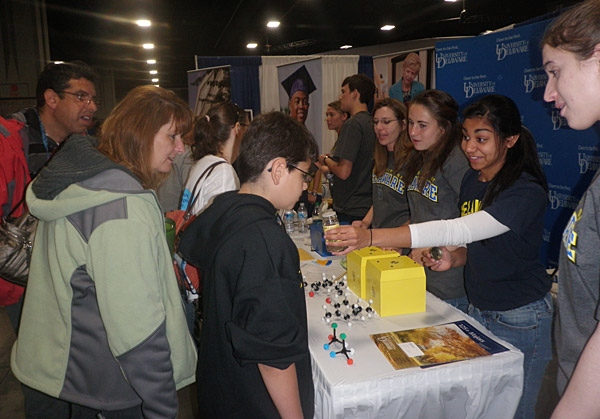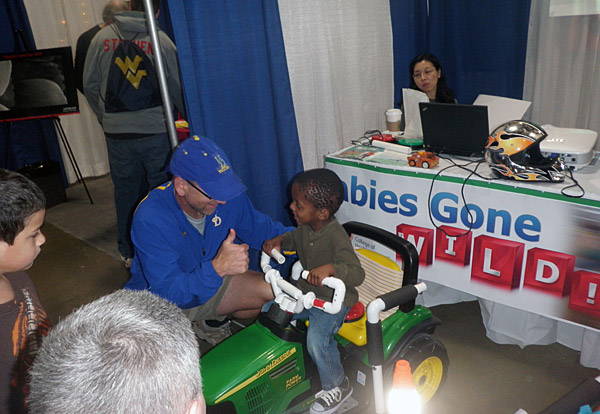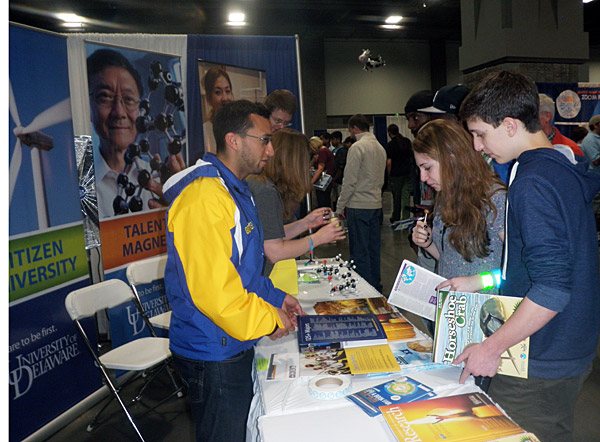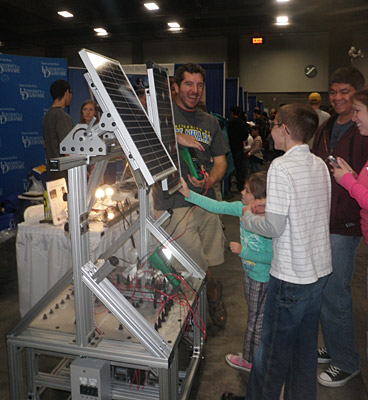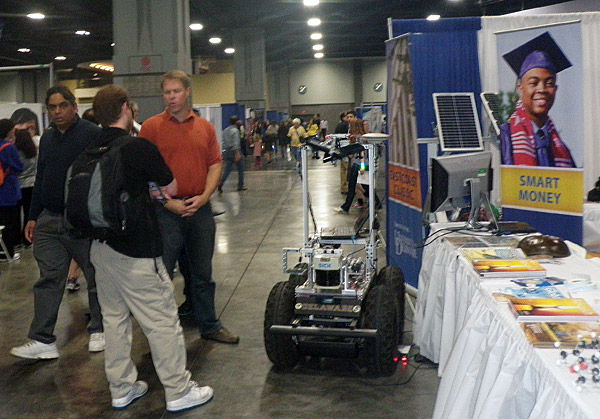

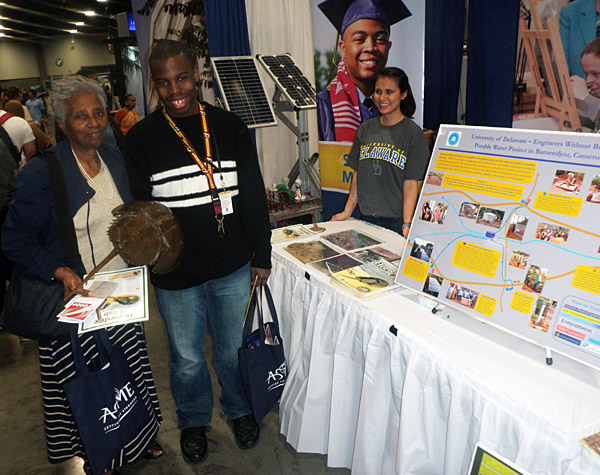
Captivating the curious
UD captivates crowds at USA Science & Engineering Festival
11 a.m., May 2, 2012--“I saw it, and I just wanted to learn more about it,” said Audrey Morris, a retired schoolteacher from Forestville, Md., as she and grandson Joshua Massey made a beeline to the University of Delaware’s booth at the USA Science & Engineering Festival in Washington, D.C.
“It” was a life-size replica of a female horseshoe crab that graduate student Emily Maung was holding. The UD graduate student explained how important Delaware’s state marine animal is to humans -- who can thank this ancient sea creature for a compound that is used to detect toxins in intravenous medications -- and to the ecosystem, where the animal’s eggs provide food for hungry shorebirds on their northward migrations each spring.
Research Stories
Chronic wounds
Prof. Heck's legacy
Maung was part of a UD contingent who presented an array of activities at the second annual national festival, which is designed to help re-invigorate public interest in science, technology, engineering and mathematics (STEM). On April 27–29, swarms of visitors, estimated at 150,000 people total, descended on the Walter E. Washington Convention Center to take part in hands-on exhibits -- more than 3,000 were offered -- plus a book fair and presentations by such superheroes as Bill Nye the Science Guy.
“I like talking about horseshoe crabs,” said Maung, a UD doctoral student in marine biosciences who grew up in Hampton Roads, Va. “I didn’t realize how important they were until I came to UD. The population is in trouble, and I wish people had more appreciation. This is one way I try to help.”
Nearby, Lindsay Shapiro, Leena Doolabh and Hannah Anderson -- from Prof. Meredith Wesolowski’s Honors General Chemistry class -- introduced visitors to enantiomers, molecules that are mirror images structurally, but have important differences. As an example, the students invited visitors to sniff caraway and spearmint, which are enantiomers of the compound carvone.
“Knowledge of these mirror-image molecules is particularly important to drug development, as often only one of a drug’s enantiomers is responsible for the desired effects you’re seeking, while the other enantiomer may be less active or even may cause adverse side effects,” Wesolowski noted.
Wesolowski challenged her students to come up with activities for the festival based on two criteria: The focus had to be on some aspect of a professor’s research in the UD Department of Chemistry and Biochemistry, and it needed to be understandable to a middle school student. Ten ideas were submitted, and two were selected for presentation. The trio of students accompanying Wesolowski chose to focus on Prof. Mary Watson’s enantiomer research.
“It’s nice to spread the world of chemistry, so kids can see that chemistry is fun,” Shapiro said, as she tested one little girl’s understanding of mirror images using two socks with opposing smiley faces.
“It’s been a good way to teach chemistry on their level -- and it’s been a learning experience for us, too,” Doolabh added.
Anderson agreed. “It’s been a great opportunity to show young kids the various research opportunities at UD, and that undergraduates can participate,” she noted.
Representatives also were on hand from the University’s Admissions Office and from the student chapter of Engineers Without Borders (UD-EWB). UD-EWB members recently built a bridge for a community in Guatemala, and they are now assessing potential new projects in Kenya and Haiti.
“I think it’s really important for kids to get involved in science and engineering early on,” said Mike Orella, a sophomore majoring in chemical engineering from Flemington, N.J. He will travel to Cameroon in June to wrap up a major UD-EWB project to bring safe drinking water to the community of Bamendjou. “I think anything people can do to foster interest in these fields is important.”
“Sneak Peek Friday” on April 27 welcomed nearly 28,000 students from schools in the D.C. area, military families, government officials and media. Ajay Prasad, professor of mechanical engineering, presented a wind power demonstration, and Kristin de Ghetaldi, a doctoral student in preservation studies, shared how Italian Renaissance artists made paint out of bug juice and eggs.
Several high-tech gizmos from UD also kept visitors in wide-eyed wonderment.
Cory Budischak, a 2011 UD doctorate alumnus in electrical and computer engineering, demonstrated the Mobile Solar Experimental System (MSES), which he and UD doctoral students Erik Koepf and Sarah Mastroianni developed. The metal contraption on wheels, equipped with tilting solar panels, is the chief product of Illuminate Learning, the company the group founded last year to provide educators with a new tool for teaching students about solar energy and other topics.
Cole Galloway, associate professor of physical therapy, brought cool racecars for kids with special needs to “Babies Gone Wild” in the National Science Foundation’s exhibit area. Galloway recently turned to off-the-shelf toy racecars to provide mobility to children who can’t crawl or walk, empowering them to be part of the action at home, in the daycare center or on the playground.
Chris Rasmussen, associate professor of computer and information sciences, demonstrated the “Warthog,” a robot that is designed to hike on a forest trail and monitor the environment, from determining if a tree may have fallen across the trail during a major storm, to assessing the biodiversity of bird life by their songs or frogs by their calls.
Rasmussen said he thinks of the “Warthog” as an “Earth rover” versus a “Mars rover” and envisions the robot as the flagship for a fleet of smaller robots, including flying robots that could look for birds’ nests or other phenomena. The robots could be looking, listening, even sniffing things, based on the sensors installed.
“I like robots and I like chatting with people -- with kids,” Rasmussen says, of his decision to participate in the festival. “Kids have lots of great questions.”
UD’s participation was organized through the UD Research Office and the Office of Communications and Marketing.
Article by Tracey Bryant




